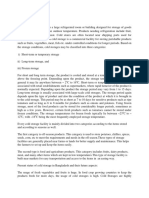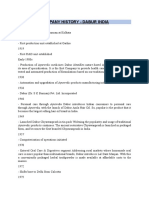1.1 Objectives
1.1 Objectives
Uploaded by
Raj KumarCopyright:
Available Formats
1.1 Objectives
1.1 Objectives
Uploaded by
Raj KumarOriginal Description:
Original Title
Copyright
Available Formats
Share this document
Did you find this document useful?
Is this content inappropriate?
Copyright:
Available Formats
1.1 Objectives
1.1 Objectives
Uploaded by
Raj KumarCopyright:
Available Formats
1.
1 OBJECTIVES 1) To study the scope of establishing cold and dry storage warehouse at salem 2) To study the various commodities and products that can be stored. 3) To suggest suitable price i.e., rental structure for the space / weight for the storage. 4) To suggest the promotional techniques for the warehouse. 5) To study the users expectations.
CHAPTER 1: INTRODUCTION OF WAREHOUSE A warehouse is a location with adequate facilities where volume shipment are received from a production centre, broken down, reassembled into combinations representing a particular order or orders, and shipped to the customer location or locations. Warehouses are scientific storage structures especially constructed for the purpose of the quantity and quality of stored products. In general, there are three groups of products under cold storage: 1. Foods that are alive at the time of storage, distribution and sale e.g. fruits and vegetables, 2. Foods that are no longer alive and have been processed in some form e.g. meat and fish products, and 3. Commodities that benefit from storage at controlled temperature e.g. beer, tobacco, khandsari, etc. and under dry storage : 1. 2.
1. NEED FOR WAREHOUSING: 1.1 SEASONAL PRODUCTION: Agricultural commodities are harvested during certain seasons, but their consumption or use takes place throughout the year. Therefore, there is a need for proper storage or warehousing for these commodities, from where they can be supplied as and required. 1.2 SEASONAL DEMAND: There are certain goods, which are in demand seasonally, like umbrellas in the rainy season. The production of these goods takes place throughout the year to meet the seasonal demand. So there is a need to store such goods in warehouse to make them available at the time of need. 1.3 CONTINUOUS PRODUCTION: Continuous production of goods in factories requires adequate supply of raw materials. So there is a need to keep sufficient quantity of stock of raw material in the warehouse to ensure continuous production to ensure continuous production. 2. TYPES OF WAREHOUSE IN SALEM: There are many types of warehouses existing on the basis of ownership, on the basis of commodities stored but this study is limited only on the bases of commodities stored in the warehouses. There are two kinds of warehouses on the bases of commodities: 1. Cold warehouse 2. Dry warehouse.
CHAPTER 2: COLD STORAGE WAREHOUSE 1. HISTORY OF COLD STORAGE India ranks first in the world in production of fruits and second in vegetables, accounting roughly 10 and 15 per cent, respectively, of total global production. India have a strong and dynamic food processing sector playing a vital role in diversifying the agricultural sector, improving value addition opportunities and creating surplus food for agro-food products. Presently, a mere 2.2 per cent of fruits and vegetables are processed, even as the country ranks second in the world in terms of production. This is comparatively low when compared to other countries like Brazil (30 per cent), USA (70 per cent) and Malaysia (82 per cent). Major vegetables grown are Potato, Onion, Tomato, Cauliflower, Cabbage, Bean, Egg Plants, Cucumber, Gherkin, Peas, Garlic and okra. The major fruits grown in India are Mangos, Grapes, Apple, Apricots, Orange, Banana Fresh, Avocados, Guava, Litchi, Papaya and Water Melons. Mango, accounts for 40 percent of the national fruit production and India is one of the leading exporters of fresh table grapes to the global market. Nearly one third of our horticultural produce, especially fruits and vegetables are wasted, mainly on account of poor cold storage and other storage facilities. The country also experiences wide fluctuations in prices of horticultural produce, particularly potatoes and onions. In spite of the per capita availability of fruits and vegetables which is quite low, the post-harvest losses, this accounts 25 to 30% of production. Besides, quality of a sizable quantity of produce also deteriorates by the time it reaches the consumers. This is mainly because of perishable nature of the producer, which requires cold chain arrangements to maintain the quality and extend the shelf life, if consumption is not meant immediately after harvest. In the absence of a cold storage and related cold chain facilities, the farmers are being forced to sell their produce immediately.
To prevent the wastage of fruits and vegetables it is important to establish a number of cold storage in different rural areas. The cold storages helps boost exports of agricultural produce, marine produce etc. With a view of ensuring faster development of cold storage capacity and encourage entrepreneurs to invest more in this sector a new credit-linked capital subsidy scheme for construction of cold storages and godowns has been introduced. The scheme was implemented by NABARD/NCDC/NHB. National Horticulture Board is providing capital subsidy to entrepreneurs for construction, expansion and modernization of cold storages for horticulture products. This scheme promotes setting up of cold storages in the country for reducing post-harvest losses. Central as well as state governments are also providing subsidy for setting up new cold storage. A new entrepreneur can well venture in to this field by installing a project of cold storage to save the fruits and vegetables from wastage. The cold storage business has been around since the 1800s, but during that time the only industry using it were the breweries and they mainly rely on the unsanitary practice of ice-harvesting. By the 1900s, the idea of cold storage has seeped into the meat packing business, until finally in the mid-20th century; these refrigeration facilities have been installed on trucks which were used to transport perishable foods to long distances. Nowadays most companies prefer to outsource their cold storage facility to relieve themselves of the trouble of having to construct and maintain their own cold storage facilities.
2. INTRODUCTION Cold storages preserve agricultural products at low temperature. The edible products are generally not stored for more than one year. Several cold storage store perishable products which require the storage temperature as low as -25C. Cold storage helps stabilize market prices and evenly distribute goods both on demand basis and time basis. The farmers get opportunity of producing cash crops to get remunerative prices. The consumers get the supply of perishable commodities with lower fluctuation of prices. Location is a very critical aspect for the success of cold storage. It should be in close proximity of growing area as well as market, be easily accessible for heavy vehicles, and have uninterrupted power supply. There are state and local laws which regulate the cold store industry, requiring safe working conditions for employees, and operational procedures must be in accordance with these laws. Those companies which do their homework and prepare in advance for inspections and other routine enforcement protocols will be able to continue operating at full capacity, ensuring greater customer service and more product flow seven days a week. Cold storage units can be used to store either a single commodity or multiple commodities. Depending upon the entrepreneur's financial health; it can be planned to store the produce entirely owned by him or on rental basis or in combination of the two. NABARD usually encourages cold storages where 70% of the capacity is available to farmers for storage on rentals. To set up a 5000 MT capacity cold storage unit although one acre of land may be adequate, it is always better to have two acres of land to take care of future expansions and waste management. While selecting the site care should be taken to select a site at an elevation free from inundation and well connected by road and other communication facilities to both production and consumption centers. The land should be of non- agricultural type and the soil at the site should be firm enough to carry the weight of the building and storage racks.
2.1 MARKET POTENTIAL Cold storages are essential for extending the shelf life, period of marketing, avoiding accumulation, reducing transport hold-ups during the peak period of production and maintenance of quality of produce. The development of cold storage industry has therefore an important role to play in reducing the wastages of the perishable commodities and thus providing remunerative prices to the growers. 2.2 LOCATION Location is a very critical aspect for the success of cold storage. It should be in close proximity of growing area as well as market and at the same time should be easily accessible for heavy vehicles round the year. Uninterrupted power supply is yet another pre-requisite. 2.3 MARKETING STRATEGY There is a good scope for vegetables and Fruits being stored in a cold storage unit. A possibility of storing some milk products also is explored. Different items are stored during different times requiring different temperatures. Hence, there is a need to divide total storage space in different temperature zones depending upon local needs. 2.4 TECHNICAL ASPECTS At present there are two popular refrigerants in the market. One is Freon and the other is Ammonia. Ammonia and Freon compressors are being manufactured indigenously. Ammonia refrigerant is cheaper, easily available and is of high latent heat of evaporation but it has certain disadvantages like being highly toxic in nature. It also forms explosive mixture when mixed with oil containing high percentage of carbon.
Rooms of different temperature must be separated by insulation and should be protected from moisture. Whenever possible, one coating of foam glass with vapour proof material should be used against the outside wall. Constant inspection must be done to prevent ice formation in the warehouse. While fixing the insulation, the points to be kept in mind are: (a) The surface to be insulated should be completely moisture proof and be reasonably even, free of lump or whole plaster on the walls. The ceiling must be cured before surface is insulated. (b) Precaution may be taken to ensure that the moisture from outside cannot penetrate through the wall, ceiling or floor. The partition wall between two chambers should be insulated both sides. Only if these points are kept in mind the cold storage can be a great success. 2.5 UTILITIES Availability of soft water and dependable power supply at the site needs to be ensured. In case the power available is not dependable, provision of a Diesel Generator set should be incorporated in the project. Similarly if water at site is not soft and its hardness is within the limit for treatment, a softening plant has to be incorporated to match the capacity. 2.6 PHYSICAL AND FINANCIAL OUTLAY The following physical provisions with their costs are considered for a cold storage unit: 1. Land. 2. Site development including leveling, fencing, road, drainage, etc. 3. Civil structures including main cold storage building, rack provisions, drying shed, machinery room, generator room, office, security cabin, etc. 4. Insulation of main cold store building.
5. Machinery for cooling, loading and weighing. 6. Electric supply arrangement including installation of transformers. 7. Standby electric supply arrangements like generators etc. 8. Water supply arrangement and treatment plant, if required 9. Pollution control and waste disposal equipment. 10. Preliminary and preoperative expenses 11. Contingency 12. Margin money for working capital The requirements for successful storage of important commodities are shown below: TABLE 1: STORAGE LIFE OF DIFFERENT COMODITIES / PRODUCTS Cold storage life (months) 3-7 4-6 3-4 9-13 9-13 17-26 26-35 40-45 4-5months
s.no 1 2 3 4 5 6 7 8 9
Name of products Apples Grapes Pine apples Oranges Carrots Onions Potatoes Chocolates Dairy products (milk, milk products)
Storage tempF 35-40 30-35 50-55 35-40 32-35 32-35 37-38 50-55 45-55
These are the commodities that can generally be stored in a cold storage warehouse. The temperature for each commodity differs and so the warehouse rooms must be partitioned and insulated depending on the temperature needs of the commodities.
TABLE 2: THE EXISTING COLD STORAGE WAREHOUSES IN SALEM S.NO NAME AND ADDRESS OF THE COLD STORAGE UNIT RANGA 1 LALITHA,KANTHAMPATTI BY PASS,SALEM 2500 CAPACITY (MTS)
SRI KRISHNA COLD 2 STORAGE, 10/5, PARANATTAMANGALAM MAIN ROAD, SALEM. Both the storage units are located in the outskirts of Salem. They are operated in full capacity for 20 hours a day. The survey was conducted in RANGA LALITHA and KRISHNA COLD STORAGE WAREHOUSE. 2500
3. RANGA LALITHA COLD STORAGE: Ranga Lalitha is the best cold storage warehouse in Salem which is 5-6km from the railway station and new bus stand. Their business is good throughout the year except in august, September and October. Their key customers are S.V.K. CHINNAKADAI STREET, OLD BUS STAND, SALEM & S.S.F, OLD BUS STAND, SALEM. The commodities stored by them are: TABLE 3: RANGA LALITHA COMMODITIES COLD STORAGE LIFE (months & years) 3 to 5 months 3 to 5 months 3 to 5 months 1 to 2 years 1 to 2 years 1 to 2 years
S.NO
NAME OF PRODUCTS Apple Orange Dates Dhal Tamarind Chillies
STORAGE TEMP C 2-5 2-5 2-5 5-8 5-8 5-8
1 2 3 4 5 6
Their key customers are S.V.K. CHINNAKADAI STREET, OLD BUS STAND, SALEM & S.S.F, OLD BUS STAND, SALEM.
TABLE 4: COST STRUCTURE OF RANGA LALITHA QUANTITY (in tons) 10 MTs 10 MTs 10 MTs PER BOX (3X4) PER BOX (3X4) RENT PER SEASON (6 MONTHS) 12,000/36,000/20,000/-
S.NO PARTICULARS 1. 2. 3. 4. TAMERIND CHILLES TURMERIC APPLES FOREIGN APPLES
RENT PER MONTH 2,000/5,000/3,000/12/-
5.
15/-
TABLE 5: MONTHLY EXPENDITURE OF RANGA LALITHA MONTHLY PARTICULARS NOS. PERSON TECHNICIANS(OPERATORS ) SUPERVISORS LABOURS SECURITY GUARDS 3 3 AS NEEDED 2 7500 10000 BASED THE WORK 5000 ON TOTAL SALARY 22500 30000 _ 10000
SALARY PER MONTHLY
TABLE 6: OTHER EXPENDITURES S.NO 1 2 MONTHLY EXPENSES ELECTRICITY FUEL COST / MONTH 1,00,000 40,000
TABLE 7: EQUIPMENTS USED S.NO 1 2 3 4 5 6 7 8 PARTICULARS Super freeze Refri-compressor Model SRA-4000 100 HP screen protected induction Motor Suitable hand operated oil immersed starter/ motor starter Ammonia oil separator Size 18" 48" Atmospheric Type Ammonia condenser Valves and fittings for the condenser Ammonia Air Cooling units Water pipe lines and fitting
3.1 RANGA LALITHA- RULES AND REGULATIONS For easy identification each boxes in the warehouses are provided with serial numbers. They deliver the products to the customers only after the verification of the serial numbers. Before loading the products in the warehouse, they are properly verified and samples are taken. They have appointed two managers in the warehouse and any work in the warehouse to be done must be signed and approved by them. Two managers must be present while opening the chamber. Only after the approval of the security, the trucks are allowed inside the warehouse. The consignment is loaded and unloaded in the warehouse only if they have the token. If the goods are damaged then it should be intimated to the respective person.
4. KRISHNA COLD STORAGE WAREHOUSE KRISHNA storage is the next best cold storage warehouse in Salem. The owner of the warehouse is a wholesale dealer of grains and so the owner is the maximum user of it. This has created minimum scope for other customers of the warehouse. The rent pattern, the commodities stored, the expenditure of the warehouse are similar to Ranga Lalitha with little variance. TABLE 8: MONTHLY EXPENDITURE OF KRISHNA WAREHOUSE MONTHLY PARTICULARS NOS. SALARY PER PERSON TECHNICIANS(OPERATORS ) SUPERVISORS LABOURS SECURITY GUARDS 2 2 AS NEEDED 2 7000 8000 BASED ON THE WORK 2000 TOTAL MONTHLY SALARY 14000 16000 _ 4000
CHAPTER 3: DRY STORAGE WAREHOUSE 1. INTRODUCTION Dry storage Warehouse is a storage structure constructed for the protection of the quality and quantity of the stored produce. The need for a dry storage warehouse arises due to the time gap between production and consumption of products. There is a need for storing the goods so as to make them available to buyers as and when required. Dry storage Warehouses enables the businessmen to carry on production throughout the year and sell their products, whenever there is adequate demand. Need for this kind of warehouses arises also because some goods are produced only in a particular season but are demanded throughout the year. Similarly, certain products are produced throughout the year but demanded only during a particular season. 2. DRY STORAGE WAREHOUSE COMMODITIES
2.1VEGETABLES Many cultures have developed innovative ways of preserving vegetables so that they can be stored for several months between harvest seasons. Techniques include pickling, home canning, food dehydration, or storage in a root cellar. 2.2GRAIN Grain which includes dry kitchen ingredients such
as flour, rice, millet, couscous, cornmeal, and so on, can be stored in rigid sealed containers to prevent moisture contamination or insect or rodent infestation. For kitchen use, glass containers are the most traditional method. During the 20th century plastic
containers were introduced for kitchen use. They are now sold in a vast variety of sizes and designs. Storage in grain sacks is ineffective; mold and pests destroy a 25 kg cloth sack of grain in a year, even if stored off the ground in a dry area. On the ground or damp concrete, grain can spoil in as little as three days, and the grain might have to be dried before it can be milled. Food stored under unsuitable conditions should not be purchased or used because of risk of spoilage. To test whether grain is still good, sprout some. If it sprouts, it is still good, but if not, it should not be eaten. It may take up to a week for grains to sprout. When in doubt about the safety of the food, throw it out as quickly as possible. 2.3 SPICES AND HERBS Spices and herbs are today often sold prepackaged in a way that is convenient for pantry storage. The packaging has a dual purpose of both storing and dispensing the spices or herbs. They are sold in small glass or plastic containers. When spices or herbs are homegrown or bought in bulk, they can be stored at home in glass or plastic containers. They can be stored for extended periods, in some cases for years. However, after 6 months to a year, spices and herbs will gradually lose their flavor as oils they contain will slowly evaporate during storage. Spices and herbs can be preserved in vinegar for short periods of up to a month, creating flavored vinegar. Alternative methods for preserving herbs include freezing in water or unsalted butter. Herbs can be chopped and added to water in an ice cube tray. After freezing, the ice cubes are emptied into a plastic freezer bag for storing in the freezer. Herbs also can be stirred into a bowl with unsalted butter, then spread on wax paper and rolled into a cylinder shape. The wax paper roll containing the butter and herbs is then stored in a freezer, and can be cut off in the desired amount for cooking. Using either of these techniques, the herbs should be used within a year.
TABLE 9 : COMMODITIES IN DRY WAREHOUSE NAME OF PRODUCTS GRAINS DHAL TURMERIC PADDY RICE ALL ELECTRONIC ITEMS HOME UTENSILS STORAGE LIFE (YRS) 1-2 1-2 1 MAX 2 1-2 DEPENDS DEPENDS
S.NO 1 2 3 4 5 6 7
TABLE 10: EXISTING DRY STORAGE WAREHOUSES IN SALEM S.NO NAME AND ADDRESS OF THE COLD STORAGE UNIT BRITANIA DRY STORAGE,SALEM AREA IN SQUARE FEET 17000
NESTLE DRY STORAGE, 2 KANDMPATTI BY PASS,SALEM. BHUVANA DRY STORAGE, 3 MOOLAPILLAYAR KOVIL STREETSALEM These storage units are located in the outskirts of Salem. The survey was conducted in BHUVANA WAREHOUSE. 3. BHUVANA DRY STORAGE WAREHOUSE Bhuvana dry storage is 6-7km from the railway station and new bus stand. Their business is good throughout the year. TABLE 11: COMMODITIES STORED BY BHUVANA DRY STORAGE WAREHOUSE NAME OF PRODUCTS GRAINS DHAL TURMERIC PADDY RICE STORAGE LIFE (YRS) 1-2 1-2 1 MAX 2 1-2 RENT PER QUINTAL (RS) 7 7 7 7 7 3500 50000
S.NO 1 2 3 4 5
TABLE10: MONTHLY EXPENDITURE MONTHLY SALARY TOTAL MONTHLY SALARY
PARTICULARS
NOS.
SUPERVISORS LABOURS SECURITY GUARDS
3 AS NEEDED 2
7,500 BASED THE WORK 5000 ON
30000 _ 10000
TABLE 11: OTHER EXPENDITURES
S.NO
MONTHLY EXPENSES
COST / MONTH
ELECTRICITY AND MAINTAINANCE COST
10,000-20,000
CHAPTER 5: MARKETING TECHNIQUES Marketing techniques for warehouse: The establishment of Weight Bridge in the warehouse will attract more customers, because no other warehouses in Salem have his facility. By canvassing the lorry transport offices and big whole sale dealers directly, by offering them discounts in rent and commissions according to their storage period would help to promote our warehouse. Establishing computerized billing and monitoring system we can provide a flexible service to the customers. By giving extra one month storage free for seasonal storage of three months. The warehouses must provide extra safety measures for the customers like automated finger print machine for entry and exit, auto recording cameras, Providing them with extra services like packaging, logistics, in order to attract more customers.
1.2 LIMITATIONS TO THE STUDY: i. The findings and suggestions in this study are taken only from the owners / occupant of the warehouse and not from the customers due to the critical schedules and insufficient time to meet the customers of warehouses. ii. Because of the insufficient information about the construction of the warehouse and its type of warehouse which is to be established, we were unable to estimate the cost structure of the warehouse. iii. The rent proposed by us is an assumption based on the competitors and the promotional activities and not on the profitability of the warehouse. iv. Our study is limited to private warehousing only. State owned set up and operation is not taken into our study.
1.3 FINDINGS: i. From the study we found that, the customers of the warehouse require convenient location for transportation rather than lower rent. ii. The rent collected by the cold storage, based on the weightage of the goods and for fruits per box rupees 15per month (3x4). Whereas in the dry storage based on weightage as well as per square feet the rent is charged. iii. The only warehouse existing with highest area is NESTLE of 50,000 square feet. iv. No warehouses in the Salem are involved in the promotional activities except RANGA LALITHA which provides two months of free storage for seasonal storage of six months. v. The workforce (labor) in the warehouse for the purpose of loading & unloading is less paid. So there is labor problem. vi. The carrying & forwarding agencies are in great demand for the warehouses with the adequate facilities and maximum area. vii. The Britania dry warehouse charges Rs.5 per square feet.
viii. ix.
The Nestle dry warehouse charges Rs.7 per square feet. The customers of the cold warehouses are provided rent according to the norms given by the warehouse association.
1.4 SUGGESTIONS 1. The establishment of the new warehouses must be in the array of the customers expectations by reducing the transportation cost. 2. The rent suggested by us is Rs.4 per square feet, Rs.7-8 based on the weightage and Rs.15 per box according to the wants of the customers. 3. The C & F agents are looking for warehouses with more than 50,000 square feet area. 4. The new warehouses and the existing ones can give more seasonal offers like providing the customers with discounts on the prices (rent) like by giving extra one month storage free for seasonal storage of three months. 5. The workforce can be provided with reasonable wages to satisfy their needs and maintain the work force diversity.
You might also like
- 7 11 Case StudyDocument17 pages7 11 Case StudyKhenjeza Pornela II100% (1)
- Project Report On Cold StorageDocument10 pagesProject Report On Cold StorageCHARAK RAY50% (2)
- Liqueur RecipesDocument24 pagesLiqueur Recipessweedld100% (2)
- Kerala-Cold StorageDocument42 pagesKerala-Cold StorageVishal Vyas100% (1)
- Case Study of Indian Cold ChainDocument10 pagesCase Study of Indian Cold ChainSampada BhootnaNo ratings yet
- Cold Storage Project ReportDocument7 pagesCold Storage Project ReportAshish Shah88% (8)
- Design of Cold Storage For Fruits and VegetablesDocument59 pagesDesign of Cold Storage For Fruits and Vegetablesluz adolfoNo ratings yet
- Project On NestleDocument68 pagesProject On NestleVivek Singh0% (2)
- Table of Content Content PageDocument22 pagesTable of Content Content PageTewodros G LeNo ratings yet
- Coconut OilDocument6 pagesCoconut Oilhunky11100% (1)
- Econometrics in Pollution ControlDocument31 pagesEconometrics in Pollution ControlJenny VarelaNo ratings yet
- Cold Storage For Plantation and Horticulture ProduceDocument14 pagesCold Storage For Plantation and Horticulture ProduceVinod Singh DikhitNo ratings yet
- Cold StorageDocument5 pagesCold StorageNilesh ThoraveNo ratings yet
- COLD STORAGE Bankable ProjectsDocument23 pagesCOLD STORAGE Bankable Projectsravi rishavNo ratings yet
- Project Report On Cold Storage Unit (Fruits & Vegetables)Document6 pagesProject Report On Cold Storage Unit (Fruits & Vegetables)EIRI Board of Consultants and Publishers100% (1)
- Cold StorageDocument50 pagesCold StoragemanishNo ratings yet
- Cold StorageDocument7 pagesCold StorageJaleel Ahmed GulammohiddinNo ratings yet
- India Ranks First in The World in Production of Fruits and Second in VegetablesDocument5 pagesIndia Ranks First in The World in Production of Fruits and Second in VegetablesrichabishtNo ratings yet
- Paper 1Document13 pagesPaper 1Yepuru ChaithanyaNo ratings yet
- Cold StorageDocument22 pagesCold Storagedineshjain11100% (2)
- Need of StorageDocument9 pagesNeed of StoragespurwonofjpNo ratings yet
- 5MT Cold RoomDocument8 pages5MT Cold RoomMaruf MominNo ratings yet
- Pre-Feasibility Study: Compartmentalized Cold StorageDocument19 pagesPre-Feasibility Study: Compartmentalized Cold StorageAzhar HussainNo ratings yet
- Cold Storage ReportDocument10 pagesCold Storage ReportMuneek ShahNo ratings yet
- Cold Storage Industry, Apmc MarketDocument59 pagesCold Storage Industry, Apmc Marketdinkar13375100% (2)
- 10MT Cold Room Project ReportDocument9 pages10MT Cold Room Project ReportRishabh SinghalNo ratings yet
- Warehousing Final ReportDocument26 pagesWarehousing Final ReportKanishk MendevellNo ratings yet
- Cold Chain IndustryDocument20 pagesCold Chain Industryazconsulting.connectNo ratings yet
- Cold Storage Fruits VegDocument72 pagesCold Storage Fruits VegMangandi RNo ratings yet
- Ass 3Document3 pagesAss 3Nick's CreationNo ratings yet
- Manish 1Document71 pagesManish 1Anurag RathiNo ratings yet
- Processing and Value Addition in Fruits and Vegetables CropsDocument9 pagesProcessing and Value Addition in Fruits and Vegetables CropsDavara Paresh R.No ratings yet
- Cold Storage of Agricultural Products PDFDocument7 pagesCold Storage of Agricultural Products PDFShrikant DeshmukhNo ratings yet
- Cold Storage - Energy Efficient Practices - V YadavDocument12 pagesCold Storage - Energy Efficient Practices - V Yadavm61367366No ratings yet
- ABE 413 Lecture NotesDocument29 pagesABE 413 Lecture Notesmasangkayr664No ratings yet
- Processing and Value Addition in Fruits and Vegetables CropsDocument9 pagesProcessing and Value Addition in Fruits and Vegetables CropsDavara Paresh R.No ratings yet
- Comprehensive Pack - Cold ChainDocument90 pagesComprehensive Pack - Cold ChainAmit RajNo ratings yet
- Commodities Backed Finance Project ReportDocument74 pagesCommodities Backed Finance Project Reportkamdica100% (2)
- Case Study - Cold StorageDocument13 pagesCase Study - Cold StorageSuhrid Sarkar50% (2)
- CooLogistics - ChilikuriDocument46 pagesCooLogistics - ChilikurirohitgjoshiNo ratings yet
- Project DeliverableDocument6 pagesProject DeliverableDissanayakeNo ratings yet
- Common Mistakes Cold Chain Infrastructure: (India)Document0 pagesCommon Mistakes Cold Chain Infrastructure: (India)Venu GopalNo ratings yet
- WarehouseDocument86 pagesWarehousemanpreet2727100% (1)
- Exp 2 PHTDocument12 pagesExp 2 PHTpradeep kumarNo ratings yet
- 1.introduction On Cold Chain LogisticsDocument26 pages1.introduction On Cold Chain LogisticsMahesh ChandraNo ratings yet
- Analysis - Cold Chain - Finally Warming Up To IndiaDocument4 pagesAnalysis - Cold Chain - Finally Warming Up To IndiaMathangiAnanthanNo ratings yet
- Cold StorageDocument31 pagesCold StorageHarpreet Singh SainiNo ratings yet
- Proj SampleDocument6 pagesProj SamplePiyush BardiaNo ratings yet
- Operations Management Project Report Based On Cold StoragesDocument21 pagesOperations Management Project Report Based On Cold StoragesGaurav YadavNo ratings yet
- Organic Farming - Post Harvest HandlingDocument10 pagesOrganic Farming - Post Harvest HandlingHenryRobertRodriguesNo ratings yet
- Modern Cold StorageDocument6 pagesModern Cold Storageडा. सत्यदेव त्यागी आर्यNo ratings yet
- Blooms in Glass : Unveiling the Secrets of Greenhouse HorticultureFrom EverandBlooms in Glass : Unveiling the Secrets of Greenhouse HorticultureNo ratings yet
- ROOT CELLARING FOR PREPPERS: Root Cellaring Techniques for Preserving Harvests and Building Self-RelianceFrom EverandROOT CELLARING FOR PREPPERS: Root Cellaring Techniques for Preserving Harvests and Building Self-RelianceNo ratings yet
- ROOT CELLARING FOR PREPPERS: A Prepper's Guide to Root Cellaring: Essential Skills for Sustainable LivingFrom EverandROOT CELLARING FOR PREPPERS: A Prepper's Guide to Root Cellaring: Essential Skills for Sustainable LivingNo ratings yet
- Quail Farming Made Easy: A DIY Handbook for Starting Your Own Quail FarmFrom EverandQuail Farming Made Easy: A DIY Handbook for Starting Your Own Quail FarmNo ratings yet
- Vegetable Forcing - Containing Information on Greenhouse Construction, Management and Frame CultureFrom EverandVegetable Forcing - Containing Information on Greenhouse Construction, Management and Frame CultureNo ratings yet
- Hydroponics_ Growing Plants without Soil for High-Yield ProductionFrom EverandHydroponics_ Growing Plants without Soil for High-Yield ProductionNo ratings yet
- The Future of Agriculture: Winners and Losers in a Post-Global Warming WorldFrom EverandThe Future of Agriculture: Winners and Losers in a Post-Global Warming WorldNo ratings yet
- Fundamental Analysis of Icici BankDocument81 pagesFundamental Analysis of Icici BankRs rsNo ratings yet
- MCX 28-Aug-12Document6 pagesMCX 28-Aug-12Raj KumarNo ratings yet
- Project On Marketing MixDocument25 pagesProject On Marketing Mixtejpratap_gupta2100% (1)
- Mutual FundDocument201 pagesMutual FundRaj KumarNo ratings yet
- Agile ManufacturingDocument17 pagesAgile ManufacturingRaj KumarNo ratings yet
- Utusan Malaysia Online - AgrobizDocument3 pagesUtusan Malaysia Online - AgrobizMarzita MunirNo ratings yet
- O'ãf"k O'ãf"k O'ãf"k O'ãf"k O'ãf"k Foi - Ku Foi - Ku Foi - Ku Foi - Ku Foi - KuDocument42 pagesO'ãf"k O'ãf"k O'ãf"k O'ãf"k O'ãf"k Foi - Ku Foi - Ku Foi - Ku Foi - Ku Foi - KuPratik GaikwadNo ratings yet
- SH Bonus Final PDFDocument19 pagesSH Bonus Final PDFAnjaneya Tiwari100% (1)
- Halal Supply Chain Management (HSCM)Document17 pagesHalal Supply Chain Management (HSCM)Salsabilla RasyidinNo ratings yet
- p3 Acca Workbook Q PDFDocument97 pagesp3 Acca Workbook Q PDFadildastiNo ratings yet
- Jose's Authentic Mexican Restaurant: Case Study Reported By: Tiffany Ariane C. Chavez Eriz Jirah P. LagundayDocument16 pagesJose's Authentic Mexican Restaurant: Case Study Reported By: Tiffany Ariane C. Chavez Eriz Jirah P. LagundayJesus Santiago100% (1)
- Supply Chain Performance Final ProjectDocument27 pagesSupply Chain Performance Final Projectpktun0% (1)
- Company HistoryDocument9 pagesCompany HistoryKanishkNo ratings yet
- PHE Preparation of Samples and Dilutions Plating and Sub-Culture PDFDocument21 pagesPHE Preparation of Samples and Dilutions Plating and Sub-Culture PDFdr Alex stanNo ratings yet
- Chocoday 1Document26 pagesChocoday 1Aditya ChauhanNo ratings yet
- Annex A VLFED FrameworkDocument2 pagesAnnex A VLFED FrameworkDanden GerraNo ratings yet
- Economic Analysis of Aquaponics and Hydroponics Production in The USMidwestDocument15 pagesEconomic Analysis of Aquaponics and Hydroponics Production in The USMidwestWei Jiang Ng100% (1)
- Oman EventsDocument12 pagesOman EventsHasna Hassan AnnacotNo ratings yet
- Soal Try Out UN 2012 SMA BAHASA INGGRIS Paket 06Document19 pagesSoal Try Out UN 2012 SMA BAHASA INGGRIS Paket 06Sri Utami0% (1)
- Potentialities and Opportunity of Citrus in Ramechhap and Sindhuli District of NepalDocument67 pagesPotentialities and Opportunity of Citrus in Ramechhap and Sindhuli District of NepalHarihar Adhikari, M. Sc.Ag. Plant Pathology67% (9)
- Decrease & Increase Priority ClientDocument86 pagesDecrease & Increase Priority ClientLydia MeiskeNo ratings yet
- Honors Project TwoDocument7 pagesHonors Project Twoapi-270008138No ratings yet
- Got MilkDocument18 pagesGot MilkAria LimNo ratings yet
- Peningkatan Dan Pengembangan Produk Olahan Kopi Di Desa BrunosariDocument13 pagesPeningkatan Dan Pengembangan Produk Olahan Kopi Di Desa BrunosariRendy StarsNo ratings yet
- Introduction Front Office OperationsDocument279 pagesIntroduction Front Office OperationsKanyoni Wa Ng'ethe100% (1)
- Cuppy Cuppy CupcakesDocument11 pagesCuppy Cuppy CupcakesDhaneletcumi Naidu VijayakumarNo ratings yet
- Raw Materials InventoryDocument5 pagesRaw Materials InventoryMae Ann Jean JustolNo ratings yet
- Coca ColaDocument88 pagesCoca Colaint007No ratings yet
- Marketing Channels On TescoDocument3 pagesMarketing Channels On TescoWissut Prutisart100% (2)






























































































